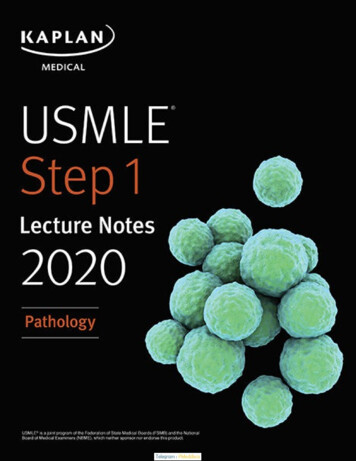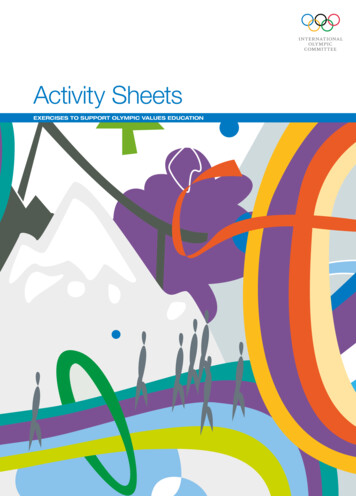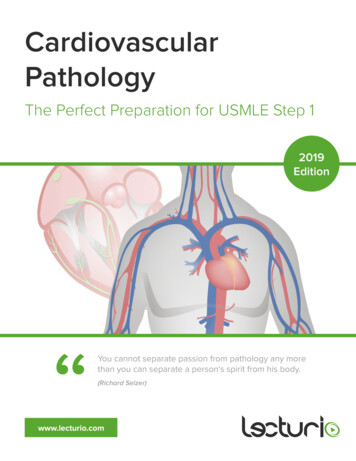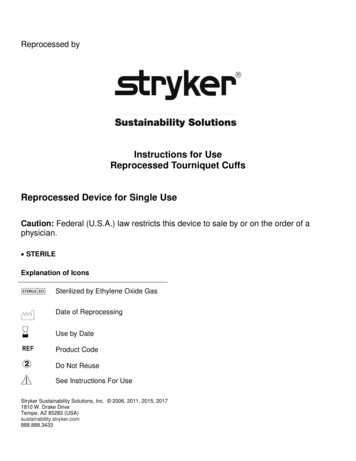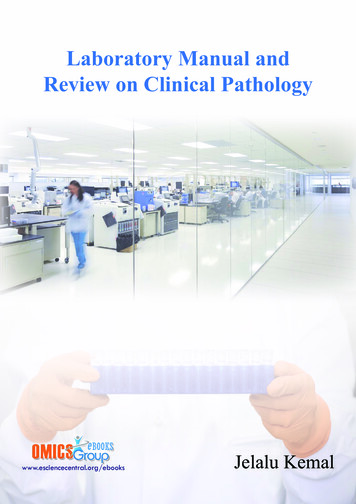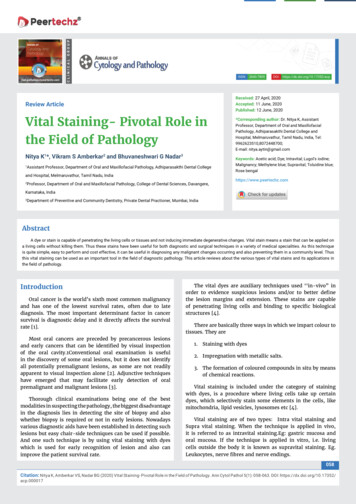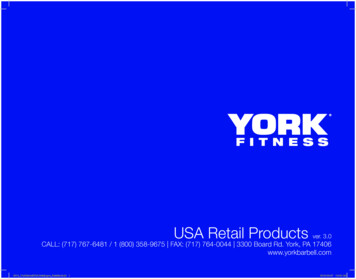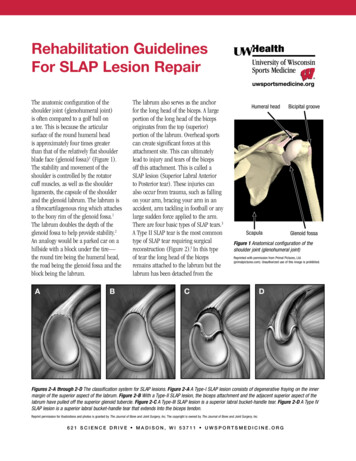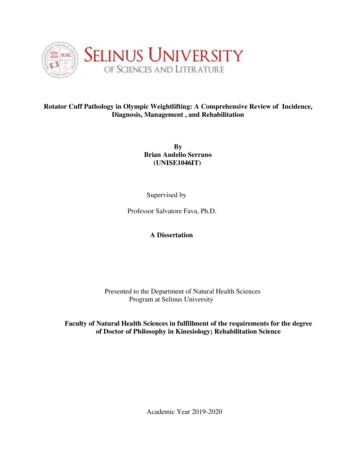
Transcription
Rotator Cuff Pathology in Olympic Weightlifting: A Comprehensive Review of Incidence,Diagnosis, Management , and RehabilitationByBrian Audelio Serrano(UNISE1046IT)Supervised byProfessor Salvatore Fava, Ph.D.A DissertationPresented to the Department of Natural Health SciencesProgram at Selinus UniversityFaculty of Natural Health Sciences in fulfillment of the requirements for the degreeof Doctor of Philosophy in Kinesiology; Rehabilitation ScienceAcademic Year 2019-2020
DeclarationI do hereby attest that I am the sole author of this project/thesis and that its contents are the onlythe results of the readings and research I have doneBrian Serrano
AcknowledgementI dedicate this paper to God, my parents Audelio and Priscilla, and Wife Jackie.Thank you God for blessing me with the opportunity to live out my dreams.To my parents Audelio and Priscilla; I will never be able to thank you enough for all ofthe sacrifices you have made for Erick and me. But let me say thank you for giving methe opportunities you never had.To my incredible wife Jackie; You are such an amazing partner and best friend to me.Thank you for always being the first one to support me and my crazy dreams.
Table of ----------------------------------Page --------------------------Page 7Chapter 1: Olympic Page 10Chapter 2: The ------Page 13Chapter 3: The Rotator ge 16Chapter 4: The Shoulder and Olympic Weightlifting---------------Page 18Chapter 5: Shoulder Injuries in Weightlifting------------------------Page 22Chapter 6: Rotator Cuff Injuries in Weightlifting--------------------Page 27Chapter 7: Diagnosis of Rotator Cuff Injuries------------------------Page 30Chapter 8: Conservative Management of Rotator Cuff Injuries----Page 35Chapter 9: Post-operative RC Repair Rehab Protocol----------------Page 39Chapter 10: Return to Weightlifting Progression----------------------Page 45Chapter 11: -----------Page -----------------------------Page 49In Defense Of My -----Page
AbstractIntroduction: Olympic Weightlifting is a sport which involves two lifts: The Clean andJerk and The Snatch. Due to the high demands on the body from the sport, injury iscommon. Injury rates tend to be lower as compared with other sports at about 2.3-3.0 per1000 contact hours. The most common injuries in Weightlifting occur at the knees, lowback, and shoulder. Injury reports within Weightlifting tend to be general and scarce. Thepurpose of this Dissertation is to explore rotator cuff injuries specific to this population ofathletes. Methods/Materials: Due to the scarcity of research in this sub-field; it wasdeemed necessary to explore journals articles, textbooks, and sports medicine books togather complete information. Pubmed, EBSCO, SPORTdiscus, and CINAHL were usedfor the systematic review portion of the paper. Analysis: SPSS Analysis was used toperform statistics during the systematic review. There was enough literature to be able toperform a meta-analysis using SPSS programs. Results: Rotator Cuff tears are commonshoulder injuries in this population that are usually chronic due to the high demandsimpose by the sport. Degenerative partial-thickness tears are common with a propensityto turn into full-thickness tears if not managed appropriately. Conclusion: Rotator cuffinjuries are common injuries in this athletic population with the rate of partial thicknesstears to the supraspinatus and infraspinatus being underdiagnosed and undertreated.Clinicians should strive to manage partial thickness tears with a trial of consistent,aggressive conservative therapy to the entire shoulder girdle and kinetic chain. If the tearis deemed to be more than 50% thickness than surgical repair is warranted for a return tosport.Key Words: Olympic Weightlifting; Weightlifting; Shoulder; Rotator Cuff Injury
IntroductionOlympic Weightlifting is a sport that has been around for hundreds of years and can betraced back to Ancient time (1). Olympic Weightlifting can be confused with other stylesof lifting such as bodybuilding, resistance training, and powerlifting (2). However,weightlifting is a sport all of its own. It involves two lifts: The Clean and Jerk and TheSnatch in which the participant aims to lift the maximal amount of weight (3) Duringcompetition, a participant has 3 attempts to get a highest “total” (4). Within the sport,there are weight classes (bodyweight in kilograms) and age classes (youth, junior, senior,master) (4). Due to the lack of professional weightlifting other than at The SummerOlympic Games level, there are less resources available into the sport as opposed to othersports that are televised and have huge followings in the United States such as: Baseball(MLB), Football (NFL), and Basketball (NBA). The national governing body (NGB) forWeightlifting in the United States (USAW) does a phenomenal job of promoting,growing , and fostering the sport. However, more resources are needed to explorepertinent topic in Sports Medicine and Sports Performance as they relate to the sport. InWeightlifting, the high demands biomechanically and physiologically imposed on thebody may lead to chronic injuries similar to those seen in other sports and athleticactivities (5). Injuries to the low back, knees, and shoulder are common and includestrains, sprains, and overuse syndromes (6). For the intents of this paper, acute injury willbe classified as a single event that led to injury and usually associated with a singlemechanism of injury (MOI). Chronic injury are those that are caused by overuse, have aslow and insidious onset that the patient may describe as bothering them for a period oftime ( 3 months) (7). Injury will be described an incident(s) that result in loss of
exposure hours to the sport (training or competition) (7). Of the common injuriesdescribed above, this paper will focus on the shoulder (Gleno-humeral joint). Theshoulder is a spheroid joint within the synovial joint classification and has movement inall three planes of motion (8). Due to anatomical incongruency of the shoulder it mustrely on static and dynamic stability which makes it vulnerable to injury (9). Injury at theshoulder includes labral pathology, instability, and rotator cuff pathology. Due to scarcityof rotator cuff pathology literature as it pertains to Olympic Weightlifting that will be thefocus of this paper. I seek to humbly gather the best current literature on this subject andsynthesize and contribute to the advancement of clinicians working with this populationof athlete. This paper will focus on the incidence, diagnosis, management, andrehabilitation of rotator cuff pathology in Olympic Weightlifters.
Shoulder Anatomy
Chapter 1: Olympic WeightliftingOlympic Weightlifting is a unique sport which can be confused with Powerlifting and otherforms of resistance training (1). Powerlifting is another sport where a participant seeks to lift amaximal amount of weight (total) with three lifts: The Bench Press, Deadlift, and Back Squat(10). Olympic Weightlifting similarly involves a participant attempting to lift a maximal amountof weight (total) in two lifts: The Snatch and The Clean and Jerk (11). Each participant has threeattempts in each lift to achieve a total. In competition, The Snatch is performed first and involvesmoving the barbell from ground to overhead in one smooth motion and demonstrating control inthe overhead position by holding still with the barbell for 3 seconds (11). There are three judgesthat either give a green or red light for each lift and a “good lift” must be determined viaunanimous decision. Common faults include “pressing out” by the elbows; ideally the athleteshould land underneath the bar with their elbows fully extended and stand the bar up. The Cleanand Jerk is performed next and involves two movements. The bar begins from the ground and ismoved to the front rack position across the shoulders and chest (11). The athletes then Jerks thebar from the shoulders to the overhead position in one movement (11). They must demonstratecontrol in the overhead position by bringing the feet to hip width apart and hold the bar still for 3seconds. There are two forms of Jerk: Split Jerk and Push Jerk. The Split Jerk involves splittingof the feet with one foot forward and the other foot back while the bar is caught with the elbowsfully extended in the overhead position and the feet are then walked back to hip width todemonstrate control. The Push Jerk involves the athlete taking hips and torso and dropping intovarying depths of a squat to get underneath the bar and standing up from this position similar toan overhead squat. Once at standing position the athletes must bring their feet to hip width apart
if the jerk brought them wider. Once again, 3 judges rule this lift good or not with similarcriteria. During the clean, elbows can’t touch the knees, or it is a no lift. These are the two lifts inOlympic Weightlifting and will form the basis for the discussions in the chapters to come.
Weightlifting Pictures
Chapter 2: The ShoulderThe shoulder (Gleno-Humeral Joint) is a spheroid (ball and socket) joint under the synovial jointclassification because it can move in all three planes of motion (12). The shoulder is inherentlyunstable due to its anatomy, which can be likened to a golf ball sitting on a tee (13). The humeralhead being the golf ball and the glenoid labrum being the tee. As you can see, there is a largedisparity in sizes which makes the shoulder mobile, which is necessary for life and activity, butalso inherently unstable. The shoulder is the most mobile joint in the body and also the mostcommonly dislocated. Dislocations usually occur in the anterior-inferior location (14).Preventing dislocation are two types of stabilizers: static and dynamic (14).2.1 Static StabilizersThe primary static stabilizers of the shoulder are the GH ligaments and labrum (15). The inferiorGH ligament (IGHL) serves to prevent anterior and posterior translation of the humerusrespectively. Each of the GH ligaments act like a sling (Inferior, Superior, Medial) to surroundthe humeral head and increase stability (16). However, the most important static stabilizer is theglenoid labrum (17). The glenoid labrum is a ring of fibrocartilaginous structure that surroundsthe entirety of the glenoid cavity increasing its surface area by about 75% in the superior-inferiordirection and 50% in the anterior-posterior direction (17). This function allows for a greatercoverage of the glenoid cavity-labrum complex over the humeral head.2.2 Dynamic StabilizersThe dynamic stabilizers of the shoulder are the rotator cuff muscles and long-head bicepscomplex. (LHBC) The rotator cuff muscles work together to promote joint centration of the
humeral head into the glenoid cavity (18). Specifically, the rotator cuff muscles acts tocounteract the superior pull from the Deltoid during shoulder abduction (18). The LHBC is a lessrecognized but is considered to be dynamic due to the contractile-transmitting forces of tendons(19) . The LHBT originates on the supraglenoid tubercle and superior labrum directly (19). Thisconnection directly into the labrum means the LHBC is responsible at least partly forstabilization the humeral head in the antero-superior aspect of its movement and activity.2.3 Scapulo-Thoracic Articulation (ST Joint)The Scapula (shoulder blade) and posterior thorax make an articulation or functional joint whichis critical for optimal shoulder function (20). The ST Joint must make a stable platform for theShoulder to function from (20). Both joints must work seamlessly for optimal function. This istermed scapula-humeral rhythm. Normal Scapulo-humeral rhythm involves the upward rotation,external rotation, and posterior tilting of the scapula followed by elevation, inferior glide, andexternal rotation of the humerus (21).2.4 MusculatureThere are several muscles that are important to optimal shoulder function: the rotator cuff aspreviously discussed, trapezius, serratus anterior, rhomboids, levator scapulae, and pectoralisminor. These muscles work in coordinated patterns called force couples to control scapularmotion. The upward rotation force couple involves the upper portion of the trapezius and thelower portion of the trapezius and serratus anterior (22).
Shoulder Stabilizers
Chapter 3: The Rotator CuffThe rotator cuff (RC) consist of 4 muscles which surround the shoulder joint and function toincrease its stability through dynamic stabilization (22). The RC serves to center the humeralhead during different movements known as Joint Centration (23). Keeping the humeral headcentered within the glenoid fossa ensures optimal function through proper length-tensionrelations. For example; during the primary phases of abduction the humeral head has abiomechanical tendency to migrate superiorly (24). During external rotation, the humeral headmigrates anteriorly and superior-anteriorly during internal rotation (24). The RC plays a crucialrole in preventing excessive motion during scapula-humeral motion. The RC is composed of theSupraspinatus, Infraspinatus, Teres Minor, and Subscapularis (22). These muscles are unique inthat all 4 have attachments directly from the scapula onto the humerus. For the purposes of thisDissertation, I will use the terms origin and insertion when referring to muscles however as putby Dr. Andrea Spina it is more accurate to think of muscles as having multiple attachments. Aswe can see, the RC is crucial to humeral and scapular function. Next, we will explore how theRC plays a particularly important role in the sport of Olympic Weightlifting.3.1 Supraspinatus (25)Origin: Supraspinous fossa of the scapulaInsertion: Greater Tubercle (Superior facet) of HumerusNerve Supply: Suprascapular NerveAction: Shoulder Abduction
3.2 Infraspinatus (26)Origin: Infraspinous fossa of the scapulaInsertion: Greater Tubercle (Middle facet) of HumerusNerve supply: Suprascapular NerveAction: External rotation of Shoulder, especially at 0 degrees of abduction3.3 Teres Minor (27)Origin: Lateral border of the scapulaInsertion: Greater Tubercle (Inferior facet) of HumerusNerve Supply: Axillary Nerve
Action: External Rotation of Shoulder, especially at 45 degrees of abduction3.4 Subscapularis (28)Origin: Subscapular FossaInsertion: Lesser Tubercle of HumerusNerve Supply: Subscapular Nerve (Upper and Lower)Action: Internal rotation and Adduction of Shoulder
Chapter 4: The Shoulder in Olympic WeightliftingNow that the anatomy and biomechanics of the shoulder have been discussed, it can be applieddirectly to Olympic Weightlifting. In general, the shoulder has been explored significantly inother sports especially overhead sports such as Baseball, Volleyball, and Javelin (29,30,31).Even contact sports like Football have explored shoulder injuries within their athletes (32).However, research in scarce in regard to recent (last 10 years) of shoulder injuries in OlympicWeightlifting (33). Olympic Weightlifters should be considered overhead athletes, although thisconcept may be faced with certain resistance. Overhead athletes in the traditional sense arethrowing an implement of some form which is easy to understand. With weightlifters, they arenot necessarily throwing anything but rather lifting a loaded a barbell overhead and in technicalterms during the Snatch and Clean portion of the Clean and Jerk actually dropping under thebarbell. I propose a new classification in this paper that Weightlifters in biomechanical terms arethrowing and catching a barbell overhead in both competition lifts.4.1 The Shoulder in the SnatchThe Snatch is the competition lift which involves lifting the barbell from ground to overhead inone fluid motion (11). There is an extreme amount on the shoulder throughout the entiremovement and is easier to follow when each lift is broken into its respective phases (34). Thefirst pull bring the bar from the floor to above the knee into the mid-thigh level. At this point, theshoulders are primarily in an isometric contraction as the rotator cuff and Latissimus Dorsifunction to pull the barbell into the body (34). The lower body is the primary mover in thisphase. (35) The second pull is when the barbell begins accelerating and triple extension occursthrough plantar flexion of the ankle, knee extension, and hip extension. (35) The shoulders are
primarily isometrically pulling the barbell into the body to keep the bar path close to the body(34). From a biomechanical perspective, keeping the bar path close to the body will make theparticipant as efficient as possible. The third pull is when the shoulders become the most activeof the three pulls (36). This is when the lifter readies their body to catch the barbell and theshoulders go into the “turnover: which is a combination of shoulder flexion, abduction, andexternal rotation. The athletes then proceeds into the turnover phase which is when the barbellwill be elevated into the overhead position and the shoulder is the most active. Once the barbellhas reached a sufficient height and the athletes has dropped into their receiving position (varyingdepth of a squat), the shoulders must work to stabilize the barbell in this overhead position. It isat this point the shoulder experiences the highest amount of isometric EMG activity due tohaving to stabilize a weighed barbell in a sub-optimal position of squatting (36). Once theshoulder has stabilized the barbell sufficiently (no excessive translation in any direction) then therecovery phase begins in which the athlete must stand with the barbell and come to a completestop, demonstrating control. Once this occurs, the lift is complete, and the athlete may drop thebarbell. Olympic plates are made of specialized material which minimizes bounce when droppeden-face making this a relatively safe maneuver. The Olympic platform is also made of shockabsorbing material and is completely level helping to reduce any bouncing of the loaded barbell.4.2 The Clean and Jerk and The ShoulderThe Clean and Jerk is the second competition lift and involves moving the barbell from theground to the shoulder, (Clean) and from the shoulder to the overhead position (Jerk) (11). Thefirst pulls moves the barbell from the ground to just below the knee through the use of the lowerextremity. The shoulders in this phase are isometrically active to keep the barbell close to the
body. (37) The second pull involves moving the bar from under the knees to about the mid-thighposition, the shoulders are simply keeping the barbell close to the body (38). Coaches will usethe cue “the arms are straps” to convey the message of not using the arms to pull the barbell andbending the elbows too early. The third pull begins when the barbell is at or close to the hipcrease and involves use of triple extension; the shoulders and arms now become active in theturnover phase. The shoulders are shrugged, and the elbows are brought up high and outsideright into aggressive forward flexion with the elbows pointed directly straight at chest level tocatch the bar. If the elbows are not quick enough, this may result in a missed lift. Once thebarbell is caught at the shoulder level the athlete will stand to complete the Clean. From here,Athletes may widen their grip to shorten the distance they must jerk the barbell overhead. TheJerk involves moving the barbell from the shoulders to overhead in one smooth motion (39). Thisbegins with the athlete performing a short dip and immediately reversing the movement to drivethe bar upward and themselves underneath the barbell. Whether a split- or push-Jerk isperformed does not matter because the shoulders are extremely active in both variations. Theshoulders are working isotonically in conjunction with the lower extremity to Jerk the barbelloverhead (40). Once the Jerk phase is over, the shoulder most turn from isotonic to isometric tostabilize the barbell overhead. The athlete then comes to a standing position and shows controlby standing still for a total of 3 seconds. The barbell can then be dropped onto the platform like itwas done on the Snatch.After learning more about the shoulder, specifically the rotator cuff and all hoe active it duringeach lift and their respective phases it is easy to see how injury can occur during weightlifting.The next chapter will explore shoulder injuries in this sport.
The Shoulder in Olympic Weightlifting
Chapter 5: Shoulder Injuries in WeightliftingThe shoulder is under large amount of compressive and distractive forces during the sport ofweightlifting 41). Weightlifters routinely lift more than bodyweight overhead; weightlifting is asport of paradox because shoulders have to be mobile enough to move the barbell beyondphysiological ranges yet be stable enough to stabilize more than bodyweight. 3 common areas ofinjury to the shoulder include: labral injuries, injuries to the long head of the biceps tendon(LHBT), and the rotator cuff.Labral InjuriesThe glenoid labrum has been described in this paper as the fibrocartilaginous covering whichsurround the entirety of the glenoid cavity to increase its surface area (42). Labral tears arecommon in overhead athletes are have been thoroughly investigated through great researcherslike Gorantla et al. Snyder et al. (43,44). The Snyder classification is composed of 4 types oflabral injuries specific to the antero-superior labrum (SLAP) tears (45). Type 1 is when thelabrum and biceps are fraying with an intact biceps anchor. Type 2 tears involve fraying of thelabrum with a detached biceps tendon anchor and are also referred to as “peel back lesions”.Type 3 SLAP tears is called a bucket handle tear and involves a tear of the labrum but the bicepsanchor is still intact. Type 4 SLAP tears are bucket handle tears that extend into the bicepstendon. Maffet et al. expanded the classification into 10 sub-types of SLAP tears continuing fromtype 4 (ie: 5-10) (46). The labrum is a 360 degrees structure making other parts vulnerable aswell. For example, anterior-inferior injuries are known as Bankart lesions and are either softtissue or bony. A soft-tissue Bankart lesion is direct damage to the anterior-inferior portion of the
labrum (47). While a bony Bankart lesion also involves a fracture to the glenoid rim in the sameanatomical area (47). Lastly, posterior labral lesions are also prevalent in the overhead athletepopulation. For example, a Kim’s lesions is a superficial tear between the posterior glenoidlabrum and glenoid articular cartilage and is postero-inferior in anatomical location (48).Another variation of posterior labral injury is overuse in nature because it is a mineralization ofthe posterior band of the inferior glenohumeral ligament (IGHL) (49). Please note this is aconcise summary of labral injuries and should not be interpreted as all-encompassing on thistopic. Labral injuries are most likely to occur during the turnover phase of the Snatch and Cleandue to the traction force imparted on the labrum. In the Snatch, the labrum is most likely injuredas the barbell goes into the turnover phase which twists the labrum onto itself in a known “peelback” mechanism of injury or traction as the barbell transitions into the overhead position.Long Head Biceps Tendon PathologyThe Long head biceps of the tendon (LHBT) is a unique structure because it originates from thesupraglenoid tubercle (50%) and labrum (50%) making it cross both the shoulder and elbowjoint (50). This Dissertation focuses on the shoulder thus will focus on the proximal portion ofthe tendon. The LHBT is both an intra-articular structure at its origin which turns extra-synovialas it passes through the anterior rotator cuff interval to enter the bicipital groove (50). The LHBThas been found to be a potent pain generator due its numerous nociceptors. Additionally, it is abiomechanically disadvantaged structure subject to overuse evident by a diffuse anteriorshoulder pain. Although, the LHBT is subject to inflammation and can be described antendonitis, a paradigm shift is happening in the field of tendon pathology. Tendinosis is a more
accurate term because of the degenerative nature without inflammation that is occurring at thetendon (50). Injuries can also occur in conjunction with the biceps reflection puller systembecause this is the internal stabilization system (51). The pulley system is formed primarily bythe superior gleno-humeral ligament (SGHL) and coraco-humeral ligament (CHL). Injury to thepulley system may lead to an increase in humeral instability and ligament translation (51). Due tothe proximal and partly intra-articular location of the tendon it can be part of other injuries. TheLHBT can be involved in labral injuries and directly involved in type 2 and 4 SLAP tears (45).These are some reasons why the proximal biceps tendon is injured and is a potent pain generatorin the shoulder. The LHBT is most likely injured from the repetitive use of shoulder shruggingcombined with forward flexion. The biceps is also active during a majority of both lifts beingsubject to chronic overuse injuries. And with its close relationship with the antero-superiorlabrum, any sort of SLAP tear has the potential to hurt the biceps anchor (52).Rotator Cuff PathologyThe rotator cuff consists of the 4 muscles which work to create the concavity-compression effectand centrate the humeral head into the glenoid cavity (53). Due to this biomechanical effect andthe large external forces imposed by a loaded barbell on the shoulder that creates multiplevectors, the function of the RC is very difficult. The RC must be strong enough to counteractthese external forces while being durable enough to work over long periods of time isotonicallyand isometrically (54). The RC is most vulnerable during the turnover phase of each lift becauseof the high amount of torque generated by the shoulder onto the RC (54). The large amount of
volume and load that accompanies weightlifting, especially during training cycles can wear theRC down. Specific RC pathology will be investigated in the following chapter.
Anatomy Relevant to Shoulder Injuries
Chapter 6: Rotator Cuff Injuries in WeightliftingThe RC is subject to extreme forces during each of the lifts due to the high loads being lifted.Specifically, the supraspinatus and infraspinatus are more commonly injured although all 4muscles can be injured (55). Part of the supraspinatus tendon is in the sub-acromial space whichcan be decreased during overhead activities such as lifting making it susceptible to injury (56).This tendon compression may be the beginning of pathologic changes leading to tendinopathy.This tendinopathy then leads to a supraspinatus tendinosis in which the tendon itself becomesdisorganized and shows mucoid degeneration at the microscopic level (57). Similarly, theinfraspinatus acting as a primary external rotator is subject to large forces during the turnoverphase of each lift, the jerk phase, and during training (58). During training, athletes may havemultiple reps, multiple variation of lifts which involve lowering the bar from either the overheadposition to the shoulders or all the way to the ground. Lowering of the barbell from a higher to alower position is an eccentric internal rotation stress on the infraspinatus and to a lesser extentthe teres minor. This eccentric internal rotation stress on the infraspinatus over time may alsolead to tendinosis. Due to the prolonged activity of the RC throughout each lift, injury mayoccur. For example, during the first two pulls of the Snatch and Clean the RC worksisometrically along with the latissimus dorsi to keep the barbell close to the body. In the thirdpull and turnover phases of both lifts the RC becomes isotonically active in moving the barbell tothe shoulders or straight into the overhead position of the snatch. Even though, the barbell shouldkeep a fairly vertical path close to the body, the sheer weight and velocity causes traction at theRC. Once training volume is factored into the patho-mechanical equation: full lifts, variation oflifts, and accessory exercises; we can see where and how injury occurs. If tendinosis continuesuntreated, volume continues increasing, or technique is poor this can lead to degenerative partial
thickness RC tears. Partial RC tears can involve any of the 4 muscles and cause symptoms ofachy pain along any aspect of the shoulder depending on the injury (59). A partial RC tear iscategorized as a tear that does not extend through their entirety of the injured area (59). Theanatomical footprint is still intact, and there are still muscle and tendon fibers intact.Management will be discussed in the next chapter but in general partial-thickness RC tears aretreated with a first-line course of conservative care. If care is not taken to manage the partialthickness it may progress into a full-thickness RC tear (60). The full-thickness RC tear isdescribed by an injury that extends the through the full muscle or tendon area (60). There is acomplete hole or defect in the area of injury and retraction may be present. Full-thickness tears iswhere most patients begin describing pseudo-paralysis where they can’t abduct their shoulderpast 90 degrees due to pain inhibition (61). Lastly, full thickness may turn into massive RC tears(MRCT) where there is significant retraction of tendons present and surgical intervention is mostlikely due to extent of damage (62). There have been many classifications of MRCT such asGerber (2 or more tendon invo
Olympic Weightlifting is a unique sport which can be confused with Powerlifting and other forms of resistance training (1). Powerlifting is another sport where a participant seeks to lift a maximal amount of weight (total) with three lifts: The Bench Press, Deadlift, and Back Squat (10). Olympic We
